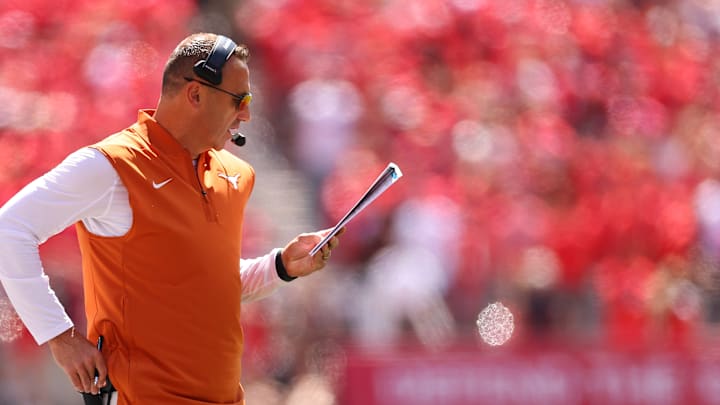Red zone execution is the most critical thing for any offense. ForSteve Sarkisian and the Texas Longhorns, the red zone is where scheme meets discipline, talent meets pressure, and championship hopes hang in the balance like last year, against the same Ohio State team. Last season, Texas finished at 63%, which put them below average nationally. Texas often looked great between the 20s, yet when the field is condensed, drives would end with field goals instead of touchdowns, or no points at all.
Is the offense too predictable inside the 20?
Sarkisian likes to use motion, misdirection, and spacing outside of the 20; when inside of the 20, those advantages take a backseat. Since last year, when he was against the same team in the playoffs, he has leaned on run-heavy packages, which good defenses are built to stop.
Texas gets stuffed on the goal line after a 70-yard drive. Longhorns now 2-9 on third downs and 1-3 on fourth downs.#HookEm
— THE STAMPEDE (@TheStampedeUT) August 30, 2025
pic.twitter.com/E9dS2nOIe9
But is the problem really Sark’s scheme, or are the players failing to execute? To me, it's a mix of both.
On one hand, pre-snap penalties like false starts or not being lined up correctly stalled plenty of Texas drives. On the other hand, some fans say that Sarkisian should trust his creativity closer to the goal line, while others argue that discipline and execution matter as much as play design. I can see and understand both viewpoints. Interestingly, on the attempts they didn't convert, a penalty or a negative play resulted in a loss of yardage. That is almost 60 % of their issue, self-inflicted wounds. Texas can fix it.
Field goals vs. Touchdowns
Texas can move the ball, but in the SEC, field goals don’t win championships — touchdowns do. Sarkisian's offense ranked 111th in red zone touchdown rate last year, which isn’t horrible but isn't good either. That might feel small on paper, but settling for three instead of six in tight games against elite defenses changes everything. Fans see it, too — every time Texas brings out the kicker instead of celebrating in the end zone, fans ask the same question:
Is this offense championship-ready, or just trying to make stuff work?
Fixing the red zone problem
I'll cut through all of the fluff here because there's a direct solution to the problem. Texas was more successful when it incorporated something special into its scheme. Why stop there? Here are my fixes for this offense:
The Longhorns are now 0-2 in the red zone today. @CoachMackBrown talked earlier this offseason about the keys to red zone success.
— THE STAMPEDE (@TheStampedeUT) August 30, 2025
pic.twitter.com/KMLThNU18m
Pre-snap penalties: These have to stop, instantly! There's no reason why a big line should be undisciplined. As my old ball Coach would say, "Hold your water".
QB-designed runs: Almost every top-ranked offense had one thing in common—a mobile quarterback. I'm not talking about a quarterback sneak; I'm talking about something more dynamic. Running up the A gap is never a good idea for a quarterback. Sarkisian must use that extra dimension.
Wrinkles: This can elevate the offense almost overnight. Returning to what they do best is the No.1 way to right the ship. The motions, misdirection, and other things make Sarkisian a tremendous offensive mind.
Run game: Keep the run game as one of the points of emphasis. Establish the run first, then the passing game will open up. Play-action will become effective, gaps will open up, and then RPOs can become a thing again.
Either way, whatever play the coach calls, the team needs to do their best to execute. The coach also has to be flexible and adapt. On the flip side, getting the perspective of your players will always take the offense up a notch. The players have a different angle from the coaches while on the field, and most times, as coaches, the ability to see the other side can be challenging.
Final remarks
For Sarkisian and Texas, there will always be this stigma of not being able to finish drives, especially in the red zone, until these changes are implemented. The good thing is this:
The issue has been presented, and the chance to solve it is there. It's up to the Longhorns now. They control their own destiny.
